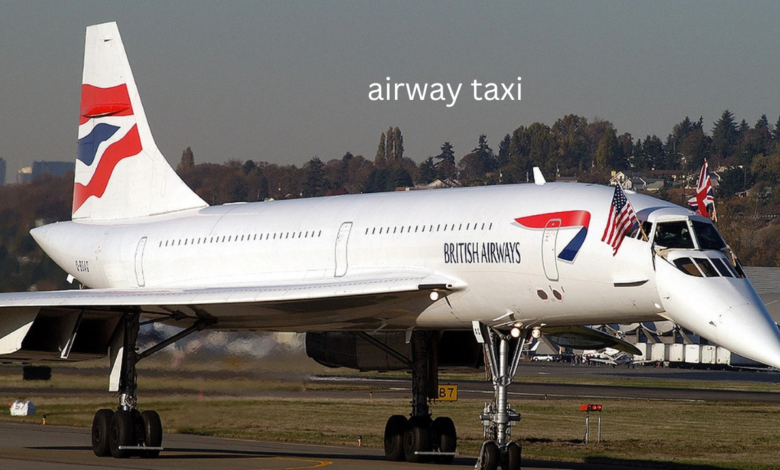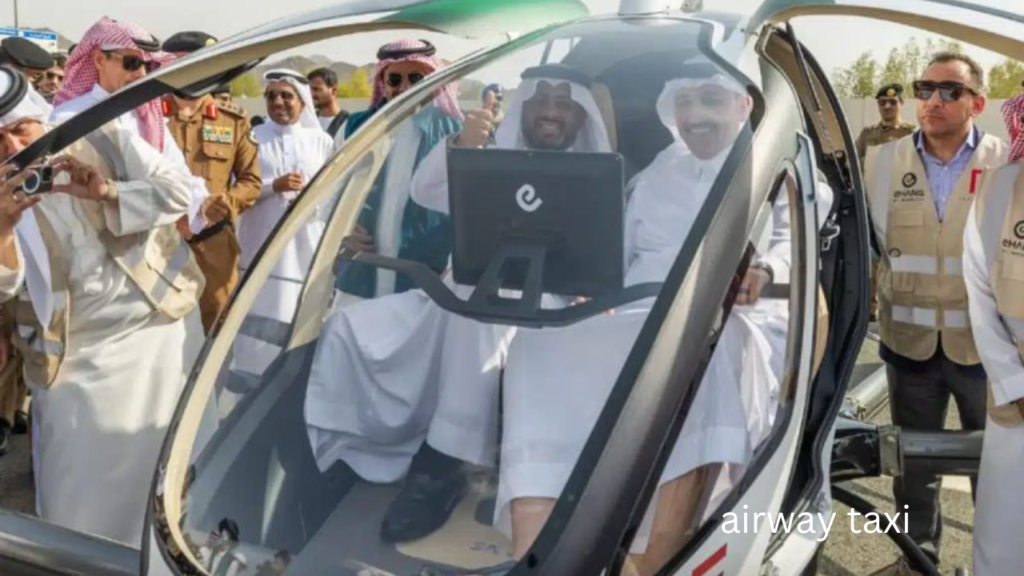Exploring the Rise of Airway Taxi Convenience Meets Innovation

In the modern world, technology is reshaping every aspect of our lives, from how we communicate to how we travel. One of the most exciting and futuristic developments in the transportation sector is the rise of airway taxi, also known as urban air mobility (UAM). This electric vertical takeoff and landing (VTOL) aircraft is poised to revolutionize how we travel within cities and metropolitan areas. In this article, we will explore the rise of airway taxi, their technological advancements, their challenges, and how they promise to redefine urban travel.
What Are Airway Taxi?
Airway taxi, often called flying taxis, are a new form of air transportation designed to transport people across urban environments. Unlike traditional helicopters or airplanes, airway taxis are more minor, lightweight, and powered by electric engines, making them more environmentally friendly. These aircraft are designed to take off and land vertically, which means they don’t need long runways and can operate from smaller spaces such as rooftops or parking lots.
The most notable feature of airway taxis is their ability to travel short to medium distances, bypassing traffic congestion and providing a faster, more efficient way to move within cities. They have the potential to alleviate congestion on the roads and offer a sustainable alternative to traditional transportation methods.
Technological Innovation Driving Airway Taxis

The rise of airway taxis has been made possible by several groundbreaking technological advancements. These innovations have addressed several challenges that previously made flying taxis impractical. Below are the key technological factors that have played a crucial role in developing airway taxis.
Electric Vertical Takeoff and Landing (eVTOL) Technology
The core technology behind airway taxis is the eVTOL, which allows these aircraft to take off and land vertically, similar to a helicopter. This means they don’t require the extensive infrastructure needed by traditional airplanes. eVTOL aircraft use multiple small electric motors to generate thrust, making them efficient and quieter than conventional aircraft.
eVTOLs are typically powered by lithium-ion batteries, which allow for a more sustainable and energy-efficient mode of transportation. However, developers are continually working to improve battery capacity and efficiency to ensure longer flight times and faster charging.
Autonomous Flight Systems
Autonomous flight is another critical element enabling the widespread adoption of airway taxis. Many companies working on airway taxis are incorporating autonomous flight systems, allowing the aircraft to fly without human intervention. These systems use a combination of sensors, cameras, and GPS technology to navigate the skies and avoid obstacles.
Autonomous technology in airway taxis can reduce human error, increase safety, and lower operational costs. While human pilots may initially be required, fully autonomous flying taxis are expected to become a reality shortly.
AI and Data Integration
Artificial intelligence (AI) plays a pivotal role in airway taxi operations. AI systems can optimize flight paths, manage air traffic, and ensure the safety and efficiency of every journey. Data analytics also allow operators to monitor the health of the aircraft in real-time, helping to predict maintenance needs and reduce the chances of unexpected failures.
Integrating AI and data systems into airway taxis can streamline operations, making the system more reliable and cost-effective.
Urban Air Traffic Management (UATM)
Airway taxis require a complex air traffic management system to ensure their safe and efficient operation within densely populated urban environments. Urban air traffic management (UATM) systems are being developed to provide real-time coordination of multiple airway taxis, ensuring they avoid collisions and congestion. These systems will work in tandem with existing air traffic control systems but are specifically designed to handle the unique challenges of urban air mobility.
Benefits of Airway Taxis
The rise of airway taxis promises numerous benefits for passengers, cities, and the environment. Let’s take a look at some of the key advantages they offer.
Reduced Traffic Congestion
One of the most significant advantages of airway taxis is their potential to reduce traffic congestion. With the increasing population in cities and the rise in vehicles on the road, traffic jams are becoming a daily frustration for commuters. Airway taxis can bypass traffic by flying above it, providing a faster and more efficient way to travel.
Reducing traffic congestion can also lead to cleaner air and improved overall quality of life in urban areas.
Environmental Sustainability
Airway taxis are designed to be environmentally friendly. They are primarily powered by electric engines, reducing the reliance on fossil fuels and emitting fewer pollutants than traditional vehicles. Flying taxis are an appealing option as more cities look to reduce their carbon footprints and promote green transportation solutions.
Additionally, the development of energy-efficient aircraft and battery technology improvements are expected to reduce airway taxis’ environmental impact further.
Speed and Convenience
Airway taxis offer a faster alternative to traditional transportation methods. With the ability to take off and land vertically, these aircraft don’t require long runways or the typical infrastructure associated with conventional air travel. Airway taxis can also bypass road traffic, drastically reducing travel time.
Passengers can enjoy a convenient and time-saving travel experience, especially during rush hours when road traffic is at its peak.
Access to Remote Areas
In many cities, reaching certain areas can be time-consuming or even impossible due to road infrastructure limitations. Airway taxis have the potential to provide access to these remote or hard-to-reach areas. By flying directly to their destinations, passengers can avoid detours and travel to locations that may be difficult to access by traditional vehicles.
Challenges Facing Airway Taxis
While the promise of airway taxis is exciting, several challenges remain to overcome before they become mainstream transportation. Some of the significant challenges include:
Regulatory Approval
Airway taxis are still in the experimental stages, and many countries have yet to develop the regulatory framework to allow for their widespread operation. Before flying taxis can operate commercially, governments must address issues such as airspace management, safety standards, and pilot qualifications.
Safety and Security
Ensuring the safety and security of passengers is paramount in developing airway taxis. While eVTOL aircraft are generally considered safe, there are still concerns about technical failures, weather conditions, and air traffic management. Additionally, with the rise of autonomous flight, ensuring cybersecurity to protect against hacking or system malfunctions will be a critical challenge.
Infrastructure Development
Although airway taxis don’t require traditional runways, they still need a network of landing pads or vertiports in urban areas. Developing this infrastructure will be costly and time-consuming, and cities must determine where these landing sites will be located to minimize disruption and maximize efficiency.
Cost
At present, the cost of developing and operating airway taxis is high. While prices are expected to decrease as technology advances and economies of scale kick in, the initial cost of flying taxis may be a barrier for many people. However, as the technology matures, the cost of air travel in cities may become more affordable and accessible to the general public.
The Future of Airway Taxis
The future of airway taxis is bright. As technology improves and urban air mobility becomes more viable, we expect widespread adoption of flying taxis in cities worldwide. The shift towards sustainable transportation and the growing need for solutions to urban congestion will only accelerate the development of this innovative technology.
In the next decade, we may see airway taxis operating in major cities, providing passengers a fast, efficient, and environmentally friendly way to navigate urban landscapes. Whether it’s commuting to work or traveling to an airport, flying taxis have the potential to become an integral part of our daily lives.
Conclusion
Airway taxis represent an exciting new frontier in transportation. With advancements in eVTOL technology, autonomous flight systems, and AI integration, they are poised to revolutionize urban mobility. As cities grow, airway taxis offer a sustainable, efficient, and convenient solution to traffic congestion problems and environmental sustainability. Although there are still challenges to overcome, the rise of airway taxis indicates that the future of transportation is not only in the air but also in the skies above our cities.
FAQs
What is an airway taxi?
An airway taxi, also a flying taxi, is an electric vertical takeoff and landing (VTOL) aircraft designed to transport passengers across urban areas. These aircraft can take off and land vertically, bypassing ground traffic and offering faster, more efficient travel.
How do airway taxis work?
Airway taxis work by using electric motors to power vertical takeoff and landing. They are typically autonomous, using sensors and AI systems to navigate safely through urban airspace. Passengers can travel directly to their destination without the need for traditional runways.
Are airway taxis safe?
While safety is a primary concern, airway taxis are designed with multiple safety features, such as redundant systems, autonomous flight controls, and real-time monitoring. However, as technology develops, regulatory authorities are working to establish comprehensive safety standards.
When will airway taxis be available for public use?
Airway taxis are still in the testing phase, but several companies are working to make them available within the next few years. Regulatory approval, infrastructure development, and technological advancements determine when they become commercially viable.
What are the environmental benefits of airway taxis?
Airway taxis are powered by electric motors, making them a more sustainable and eco-friendly option than traditional vehicles. They produce fewer emissions and reduce the reliance on fossil fuels, helping to combat urban pollution and reduce the overall carbon footprint.
You May Also Read: https://snokido.org.uk/merchant-circle/




